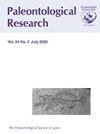日本福井县小野市Kuzuryu地区Tetori群Itsuki组兽脚亚目牙齿的形态计量学和进化分析
IF 0.6
4区 地球科学
Q3 PALEONTOLOGY
引用次数: 0
摘要
摘要在日本中部福井县小野市Kuzuryu地区的Tetori群的Hauterivian-Barremian Itsuki组中发现了一颗孤立的兽脚亚目牙齿。目前的标本OMFJ V-1显示厚的披针形基底横截面和小的中、远端齿。基于牙齿特征的枝型分析表明,omfjv -1属异特龙总科或暴龙总科。主成分分析和线性判别分析也表明OMFJ V-1属于这两个兽脚亚目中的一个。线性判别分析的后验概率表明,异特龙总分类的置信度略高于霸王龙科分类的置信度。然而,由于这些分析在较小程度上也支持OMFJ V-1属于其他兽脚亚目分支的可能性,因此其分类归属仍然不明确。如果OMFJ V-1属于暴龙总科,这将表明在Hauterivian-Barremian时代,中型暴龙已经出现在日本中部。另一方面,如果OMFJ V-1属于异特龙总科,则表明该地区至少有异特龙和暴龙两种大中型兽脚亚目恐龙几乎同时生活。第三种可能是OMFJ V-1属于巨盗龙。如果这种亲缘关系得以确立,它将代表这一兽脚亚目分支最古老的记录。本文章由计算机程序翻译,如有差异,请以英文原文为准。
Morphometric and Cladistic Analyses of a Theropod Tooth from the Itsuki Formation of the Tetori Group in the Kuzuryu District, Ono City, Fukui Prefecture, Japan
Abstract. An isolated theropod tooth was found in the Hauterivian–Barremian Itsuki Formation of the Tetori Group in the Kuzuryu district, Ono City, Fukui Prefecture, central Japan. The present specimen, OMFJ V-1, shows a thick lanceolate basal cross-section and small mesial and distal denticles. A cladistic analysis based on the dental characters suggested that OMFJ V-1 be classified as belonging to Allosauroidea or Tyrannosauroidea. Principal component and linear discriminant analyses also suggested that OMFJ V-1 belongs to either of these two theropod clades. The posterior probabilities obtained in the linear discriminant analyses indicated that the confidence of the classification as Allosauroidea is slightly higher than that for Tyrannosauridae. However, because these analyses also supported possibilities of OMFJ V-1 belonging to other theropod clades to lesser extents, its taxonomic referral remains ambiguous. If OMFJ V-1 belongs to Tyrannosauroidea, it would indicate that a medium-sized tyrannosauroid already appeared in central Japan during the Hauterivian–Barremian age. On the other hand, if OMFJ V-1 belongs to Allosauroidea, it would indicate that at least two medium-to-large-sized theropods, allosaurids and tyrannosaurids, lived almost coevally in this region. The third possibility is that OMFJ V-1 belongs to Megaraptora. If such affinities are established, it would represent the oldest record of this clade of theropods.
求助全文
通过发布文献求助,成功后即可免费获取论文全文。
去求助
来源期刊

Paleontological Research
PALEONTOLOGY-
CiteScore
1.60
自引率
0.00%
发文量
47
审稿时长
>12 weeks
期刊介绍:
Paleonotological Research (PR) is a quarterly, peer-reviewed international journal, which focuses on original contributions primarily in the area of paleontology but also covering a wide range of allied sciences. It has been published since 1997 as a successor to the former journal Transactions and Proceedings of the Palaeontological Society of Japan. The emphasis of contributions will include global and local perspectives, and contents can cover all ages (Precambrian to the Quaternary, including the present time).
 求助内容:
求助内容: 应助结果提醒方式:
应助结果提醒方式:


